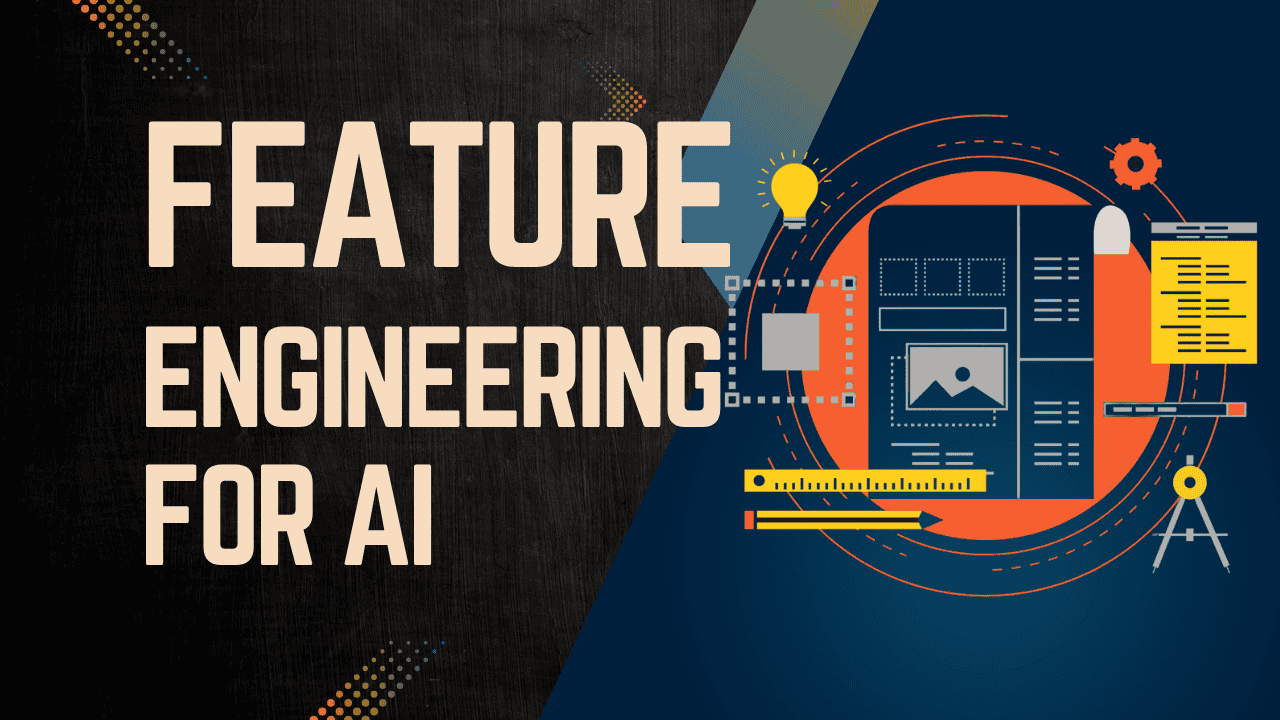Key Points:
- Feature engineering is the process of transforming raw data into a format that improves the performance of AI models, making predictions more accurate.
- It involves techniques like converting categories to numbers, adjusting numerical data, combining features, and processing text data.
- While often underappreciated, it seems likely that effective feature engineering can significantly enhance model outcomes, sometimes more than model selection itself.
- The process requires creativity and domain knowledge, and there’s no one-size-fits-all approach, as different datasets and problems demand tailored solutions.
Introduction
In the world of artificial intelligence (AI) and machine learning, the quality of the data you feed into a model is just as important as the model itself. While much attention is given to choosing the right algorithms or fine-tuning parameters, feature engineering often remains an unsung hero. Yet, it’s this critical step that can transform raw, messy data into a format that unlocks a model’s full potential, leading to more accurate and reliable predictions.
Feature engineering is the process of using domain knowledge to create or transform data features—specific attributes or variables—that make machine learning models perform better. It’s like preparing ingredients for a gourmet meal: raw vegetables and spices need to be chopped, seasoned, and combined thoughtfully to create a dish that shines. Similarly, raw data needs careful preparation to highlight the patterns and relationships that AI models rely on to make predictions.
This article explores feature engineering in a way that’s easy to understand, using simple language, real-world analogies, and practical examples. We’ll cover what feature engineering is, the main techniques used, best practices, and common pitfalls to avoid. Whether you’re new to data science or a seasoned professional, this guide will help you appreciate the power of feature engineering and how it bridges the gap between raw data and actionable insights.
On This Page
Table of Contents
What is Feature Engineering?
At its core, feature engineering is about taking raw data—numbers, categories, text, or other formats—and transforming it into a form that’s more useful for machine learning models. Raw data, as it exists in the real world, is often messy, incomplete, or not directly compatible with the algorithms used in AI. Feature engineering addresses these challenges by creating new features or modifying existing ones to better represent the underlying patterns in the data.
In the broader context of data science, feature engineering sits between data collection and model building. It’s part of what’s sometimes called data pipelines, ETL (Extract, Transform, Load), or data transformations. While these terms may have specific meanings in other fields, in data science, they generally refer to the same idea: preparing data to maximize a model’s ability to predict outcomes.
For example, imagine you have a dataset of customer purchases with a column for “payment method” (e.g., “credit card,” “cash,” “digital wallet”). Most machine learning models can’t directly process text like this, so feature engineering might involve converting these categories into numerical values that the model can understand. Similarly, numerical data like income might be skewed, with a few very high values, so you might apply a transformation to make it more balanced.
Feature engineering is both an art and a science. It requires technical skills to manipulate data and creativity to decide which transformations will reveal the most useful patterns. It also relies heavily on domain knowledge—understanding the context of the data and the problem you’re trying to solve.
Why Feature Engineering Matters
Feature engineering is often underappreciated, but it can have a bigger impact on model performance than the choice of algorithm. A well-engineered feature can make a simple model perform exceptionally well, while poorly prepared data can hinder even the most advanced algorithms.
To illustrate, consider a real-world analogy: photography. A raw photo straight from a camera might be blurry or poorly lit. By adjusting brightness, cropping distractions, or applying filters, a photographer enhances the image to highlight its best qualities. Similarly, feature engineering refines raw data to bring out the patterns that matter most to the model.
Another analogy is cooking. Raw ingredients like vegetables, spices, and meat need preparation—chopping, seasoning, or marinating—before they can be cooked into a delicious meal. Feature engineering is like this preparation, ensuring the data is in the best possible form for the model to “cook” into accurate predictions.
By investing time in feature engineering, data scientists can:
- Improve model accuracy by making patterns more apparent.
- Reduce the complexity of the model needed, saving computational resources.
- Make models more robust to noise and variations in the data.
Types of Feature Engineering
Feature engineering encompasses a variety of techniques, each suited to different types of data and problems. Below, we explore some of the most common methods, complete with examples and explanations.
1. Handling Categorical Data: One-Hot Encoding
Categorical data represents discrete categories, such as “yes/no,” “red/green/blue,” or “small/medium/large.” Since most machine learning models require numerical input, we need to convert these categories into numbers. One of the most common techniques is one-hot encoding, also known as dummy variables.
In one-hot encoding, each category is transformed into a binary column (0 or 1). For example, if you have a feature “Subscribed” with values “Yes” and “No,” one-hot encoding creates two new columns: “Subscribed_Yes” and “Subscribed_No.” A “Yes” value becomes (1, 0), and a “No” value becomes (0, 1).
Example:
| Customer ID | Subscribed |
|---|---|
| 1 | Yes |
| 2 | No |
| 3 | Yes |
After one-hot encoding:
| Customer ID | Subscribed_Yes | Subscribed_No |
|---|---|---|
| 1 | 1 | 0 |
| 2 | 0 | 1 |
| 3 | 1 | 0 |
This transformation ensures the model doesn’t assume any ordinal relationship between categories (e.g., that “Yes” is greater than “No”).
2. Transforming Numerical Data: Log Transformation
Numerical data can sometimes have distributions that are problematic for models. For instance, features like income or time-to-event data are often skewed, with most values being small but a few being very large. This can make it harder for models to learn effectively, especially for algorithms that assume normally distributed data.
A common solution is to apply a mathematical transformation, such as taking the natural logarithm, square root, or inverse. The logarithmic transformation, in particular, is widely used to reduce skewness and compress large values.
Example:
| Customer ID | Income |
|---|---|
| 1 | 50000 |
| 2 | 100000 |
| 3 | 150000 |
After log transformation:
| Customer ID | Log_Income |
|---|---|
| 1 | 10.82 |
| 2 | 11.51 |
| 3 | 11.92 |
This makes the data more balanced and easier for models to process.
3. Creating Interaction Features
Sometimes, the relationship between two features is more informative than the features themselves. Interaction features are created by combining existing features, often through mathematical operations like multiplication or division.
For example, in a dataset predicting house prices, the number of bedrooms and bathrooms might be individually useful, but their ratio (bedrooms per bathroom) could capture a more nuanced relationship that affects price.
Example:
| House ID | Bedrooms | Bathrooms |
|---|---|---|
| 1 | 3 | 2 |
| 2 | 4 | 2 |
| 3 | 2 | 1 |
After creating an interaction feature:
| House ID | Bedrooms | Bathrooms | Bedrooms_per_Bathroom |
|---|---|---|---|
| 1 | 3 | 2 | 1.5 |
| 2 | 4 | 2 | 2.0 |
| 3 | 2 | 1 | 2.0 |
This new feature might help the model better predict house prices.
4. Text Data Processing: Summarization and TF-IDF
Text data, such as customer reviews or documents, requires special handling. One approach is to summarize the text or extract key information, such as names, dates, or keywords, to create structured features. Another common method is TF-IDF (Term Frequency-Inverse Document Frequency), which converts text into numerical vectors based on the importance of words.
For instance, in a dataset of product reviews, TF-IDF can highlight words that are unique and significant in each review, helping the model focus on meaningful content.
Example:
| Review ID | Text |
|---|---|
| 1 | “The product is great!” |
| 2 | “I didn’t like the product.” |
After TF-IDF, each review is represented as a vector of numerical scores for words in the vocabulary, which the model can use for tasks like sentiment analysis.
Real-World Analogies
To make feature engineering more relatable, let’s explore two analogies:
Cooking Analogy
Imagine you’re a chef preparing a meal. Your raw ingredients—vegetables, spices, meat—are like raw data. Feature engineering is the preparation process: chopping vegetables (transforming data), mixing spices (combining features), and marinating meat (enhancing features). Just as these steps make the ingredients more suitable for cooking, feature engineering makes data more suitable for modeling.
Photography Analogy
In photography, a raw image from a camera might need adjustments to look its best. Cropping removes distractions (selecting relevant features), adjusting brightness balances the image (scaling features), and applying filters enhances details (transforming features). Feature engineering does the same for data, refining it to highlight the patterns that matter.
Coding Examples
Let’s dive into some practical Python code to demonstrate feature engineering techniques using popular libraries like pandas and numpy.
Example 1: One-Hot Encoding
This code converts a categorical feature into dummy variables.
import pandas as pd
# Sample dataframe
df = pd.DataFrame({
'Color': ['Red', 'Green', 'Blue', 'Green']
})
# One-hot encoding
df_encoded = pd.get_dummies(df, columns=['Color'])
print(df_encoded)
Output:
| Color_Blue | Color_Green | Color_Red | |
|---|---|---|---|
| 0 | 0 | 0 | 1 |
| 1 | 0 | 1 | 0 |
| 2 | 1 | 0 | 0 |
| 3 | 0 | 1 | 0 |
Example 2: Log Transformation
This code applies a logarithmic transformation to a numerical feature.
import numpy as np
import pandas as pd
# Sample dataframe
df = pd.DataFrame({
'Value': [1, 10, 100, 1000]
})
# Log transformation
df['Log_Value'] = np.log(df['Value'] + 1) # Adding 1 to avoid log(0)
print(df)Output:
| Value | Log_Value | |
|---|---|---|
| 0 | 1 | 0.693147 |
| 1 | 10 | 2.397895 |
| 2 | 100 | 4.615121 |
| 3 | 1000 | 6.908755 |
Example 3: Creating Interaction Features
This code creates a new feature by multiplying two existing features.
# Sample dataframe
df = pd.DataFrame({
'Feature1': [1, 2, 3],
'Feature2': [4, 5, 6]
})
# Creating interaction feature
df['Interaction'] = df['Feature1'] * df['Feature2']
print(df)Output:
| Feature1 | Feature2 | Interaction | |
|---|---|---|---|
| 0 | 1 | 4 | 4 |
| 1 | 2 | 5 | 10 |
| 2 | 3 | 6 | 18 |
Best Practices for Feature Engineering
To make the most of feature engineering, follow these best practices:
- Exploratory Data Analysis (EDA): Spend time exploring the data to understand its distributions, relationships, and potential issues. Visualizations like histograms or scatter plots can reveal patterns that guide feature engineering.
- Leverage Domain Knowledge: Use expertise in the field to create features that capture meaningful aspects of the problem. For example, in finance, creating a feature for “debt-to-income ratio” might be more predictive than raw debt or income values.
- Iterate and Test: Feature engineering is an iterative process. Test different transformations and evaluate their impact on model performance using metrics like accuracy or mean squared error.
- Handle Missing Values: Decide how to handle missing data, whether by imputing values (e.g., using the mean or median) or removing incomplete records, based on the context.
- Avoid Data Leakage: Ensure that features don’t include information that wouldn’t be available at prediction time, such as using future data in a time-series model.
Common Mistakes to Avoid
Feature engineering can go wrong if not done carefully. Here are some pitfalls to watch out for:
- Overfitting: Creating too many features or overly complex ones can lead to models that perform well on training data but poorly on new data.
- Ignoring Feature Scaling: Some algorithms, like support vector machines or k-nearest neighbors, require features to be on the same scale. Failing to scale features can degrade performance.
- Not Validating Transformations: Always check if a transformation improves model performance. Applying transformations blindly can distort the data.
- Using Future Information: In time-series data, ensure features don’t use information from the future, as this can lead to unrealistic performance estimates.
Conclusion
Feature engineering is a cornerstone of effective machine learning, transforming raw data into a format that empowers models to make accurate predictions. By applying techniques like one-hot encoding, log transformations, interaction features, and text processing, data scientists can unlock the hidden potential in their data.
This process is both an art and a science, requiring creativity, domain knowledge, and rigorous testing. With well-engineered features, even simple models can achieve remarkable results, while poorly prepared data can hinder even the most advanced algorithms.
As you embark on your feature engineering journey, experiment with different techniques, validate their impact, and leverage domain expertise to guide your decisions. By mastering feature engineering, you’ll be better equipped to build robust, high-performing AI models that deliver actionable insights.

FAQs
What is feature engineering in simple terms?
Answer:
Feature engineering is like preparing ingredients before cooking a meal. It’s the process of taking raw data—like numbers, categories, or text—and turning it into a format that helps AI models understand and predict better. For example, if you have data about house sizes and locations, feature engineering might involve creating a new feature like “size per room” to make the data more useful for predicting house prices.
Why is feature engineering important for AI?
Answer:
Feature engineering is important because raw data is often messy or not in a form that AI models can easily use. Think of it like giving a student a messy textbook versus clear, organized notes. Good feature engineering makes patterns in the data clearer, so the AI can make more accurate predictions. It can even make a simple model perform better than a complex one with poor data.
What are some common feature engineering techniques?
Answer:
Here are a few common ways to do feature engineering:
Turning categories into numbers: For example, changing “yes/no” answers into 1s and 0s so the model can understand them.
Adjusting numbers: Taking the logarithm of something like income to make it less skewed (spread out more evenly).
Combining features: Multiplying two features, like height and width, to create a new one, like area.
Simplifying text: Summarizing a long document or pulling out key words to make text data easier for the model to use.
What’s the difference between feature engineering and data cleaning?
Answer:
Data cleaning is about fixing errors in the data, like filling in missing values or removing duplicates. It’s like tidying up a messy room. Feature engineering, on the other hand, is about taking that cleaned data and making it better for the AI model, like rearranging the room to make it more functional. For example, data cleaning might fix a typo in a customer’s age, while feature engineering might create a new feature like “age group” (e.g., young, adult, senior).
Do I need to be an expert to do feature engineering?
Answer:
No, you don’t need to be an expert, but it helps to understand your data and the problem you’re solving. Feature engineering is like solving a puzzle—you try different ways to transform the data and see what works best. Knowing the basics of data (like numbers and categories) and some simple coding (like Python) is enough to get started. Over time, you’ll get better with practice and by learning what makes your model perform better.
Can feature engineering make a model too complicated?
Answer:
Yes, it can if you’re not careful. Creating too many features or overly complex ones can confuse the model, like adding too many ingredients to a recipe and ruining the dish. This can lead to overfitting, where the model works great on your training data but poorly on new data. To avoid this, test your features and keep only the ones that actually improve your model’s predictions.
How do I know which features to create?
Answer:
It’s a bit like experimenting in the kitchen—you try things based on what you know about the ingredients (your data) and the dish (your goal). Start by exploring your data to spot patterns, like whether certain numbers are skewed or if categories seem important. Use your knowledge of the problem—for example, if you’re predicting car prices, features like “miles per gallon” or “age of the car” might matter. Then, test your new features to see if they help the model.
What’s an example of feature engineering in real life?
Answer:
Imagine you’re building an AI to predict if someone will buy a product. Your raw data includes their age, income, and whether they visited your website (yes/no). Feature engineering might involve:
Converting “yes/no” website visits into 1s and 0s.
Creating a new feature like “income per age” to capture how wealth changes with age.
Grouping ages into categories like “young” or “senior” to simplify patterns.
These changes make it easier for the AI to spot who’s likely to buy.
Do all AI models need feature engineering?
Answer:
Not always, but it’s usually helpful. Some advanced models, like deep learning, can automatically find patterns in raw data, but even then, good feature engineering can make them work better or faster. For simpler models, like decision trees or linear regression, feature engineering is often essential because they rely heavily on well-prepared data to perform well.
How do I avoid mistakes in feature engineering?
Answer:
Here are some tips to avoid common mistakes:
Don’t use future information: If you’re predicting something like stock prices, don’t use data that wouldn’t be available at the time of prediction.
Keep it simple: Avoid creating too many features, as it can confuse the model.
Test your features: Always check if your new features improve the model’s performance using a test dataset.
Understand your data: Make sure your transformations make sense for the problem, like not taking the logarithm of negative numbers.








